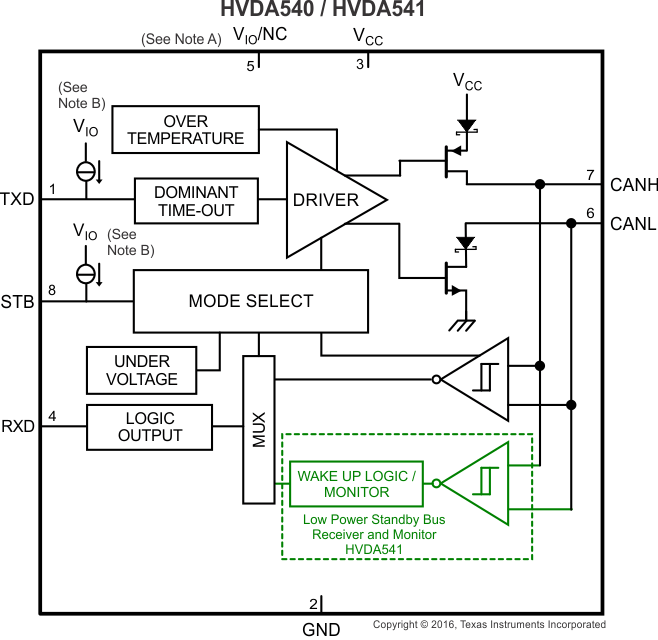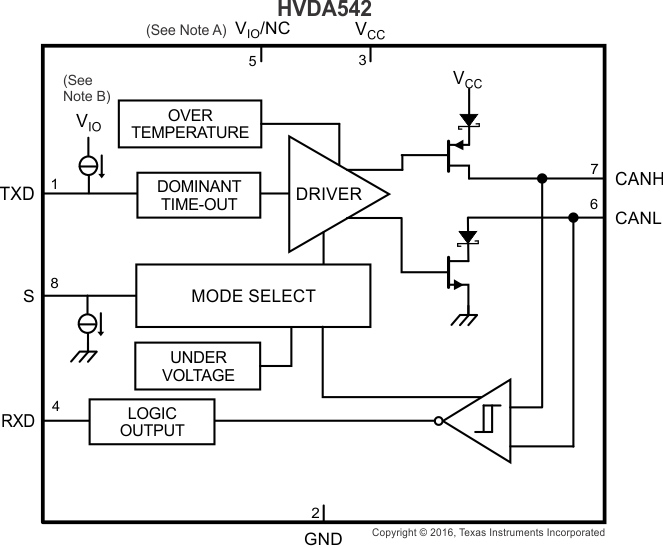SLLS804D March 2009 – August 2016 SN65HVDA540-5-Q1 , SN65HVDA540-Q1 , SN65HVDA541-5-Q1 , SN65HVDA541-Q1 , SN65HVDA542-5-Q1 , SN65HVDA542-Q1
PRODUCTION DATA.
- 1 Features
- 2 Applications
- 3 Description
- 4 Revision History
- 5 Pin Configuration and Functions
- 6 Specifications
- 7 Parameter Measurement Information
- 8 Detailed Description
- 9 Application and Implementation
- 10Power Supply Recommendations
- 11Layout
- 12Device and Documentation Support
- 13Mechanical, Packaging, and Orderable Information
1 Features
- Qualified for Automotive Applications
- AEC-Q100 Qualified With the Following Results:
- Device Temperature Grade 1: –40°C to 125°C
- Device HBM ESD Classification Level 3A
- Device CDM ESD Classification Level C6
- Device MM ESD Classification Level M4
- Meets or Exceeds the Requirements of ISO 11898-2 and ISO 11898-5
- GIFT/ICT Compliant
- ESD Protection up to ±12 kV (Human-Body Model) on Bus Pins
- I/O Voltage Level Adapting
- SN65HVDA54x: Adaptable I/O Voltage Range (VIO) From 3 V to 5.33 V
- SN65HVDA54x-5: 5 V VCC Device Version
- Operating Modes:
- Normal Mode: All Devices
- Low Power Standby Mode (VCC Not Required, Only VIO Supply Needed Saving System Power)
- SN65HVDA540: No Wake Up
- SN65HVDA541: RXD Wake Up Request
- Silent (Receive Only) Mode: HVDA542
- High Electromagnetic Compliance (EMC)
- Protection
- Undervoltage Protection on VIO and VCC
- Bus-Fault Protection of –27 V to 40 V
- TXD Dominant State Time Out
- RXD Wake Up Request Lock Out on CAN Bus Stuck Dominant Fault (HVDA541)
- Thermal Shutdown Protection
- Power-Up/Down Glitch-Free Bus I/O
- High Bus Input Impedance When Unpowered (No Bus Load)
2 Applications
- SAE J2284 High-Speed CAN for Automotive Applications
- SAE J1939 Standard Data Bus Interface
- GMW3122 Dual-Wire CAN Physical Layer
- ISO 11783 Standard Data Bus Interface
- NMEA 2000 Standard Data Bus Interface
3 Description
The SN65HVDA54x-Q1 and SN65HVDA54x-5-Q1 devices, known as the HVDA54x and HVDA54x-5 respectively, are designed and qualified for use in automotive applications and meets or exceeds the specifications of the ISO 11898 High Speed CAN (Controller Area Network) Physical Layer standard (transceiver).
Device Information(1)
| PART NUMBER | PACKAGE | BODY SIZE (NOM) |
|---|---|---|
| SN65HVDA54x-Q1, SN65HVDA54x-5-Q1 | SOIC (8) | 4.90 mm × 3.91 mm |
- For all available packages, see the orderable addendum at the end of the data sheet.
HVDA54x Functional Block Diagram

HVDA54x devices pin 5 is VIO. HVDA54x-5 devices pin 5 is NC and VIO is internally connected to VCC.
HVDA54x-5 Functional Block Diagram

HVDA54x-5 devices: VIO is internally connected to VCC